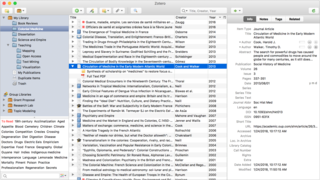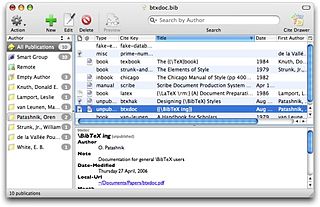
LaTeX is a software system for typesetting documents. LaTeX markup describes the content and layout of the document, as opposed to the formatted text found in WYSIWYG word processors like Microsoft Word, LibreOffice Writer and Apple Pages. The writer uses markup tagging conventions to define the general structure of a document, to stylise text throughout a document, and to add citations and cross-references. A TeX distribution such as TeX Live or MiKTeX is used to produce an output file suitable for printing or digital distribution.

A citation is a reference to a source. More precisely, a citation is an abbreviated alphanumeric expression embedded in the body of an intellectual work that denotes an entry in the bibliographic references section of the work for the purpose of acknowledging the relevance of the works of others to the topic of discussion at the spot where the citation appears.

LyX is an open source, graphical user interface document processor based on the LaTeX typesetting system. Unlike most word processors, which follow the WYSIWYG paradigm, LyX has a WYSIWYM approach, where what shows up on the screen roughly depicts the semantic structure of the page and is only an approximation of the document produced by TeX.

XeTeX is a TeX typesetting engine using Unicode and supporting modern font technologies such as OpenType, Graphite and Apple Advanced Typography (AAT). It was originally written by Jonathan Kew and is distributed under the X11 free software license.
CiteULike was a web service which allowed users to save and share citations to academic papers. Based on the principle of social bookmarking, the site worked to promote and to develop the sharing of scientific references amongst researchers. In the same way that it is possible to catalog web pages or photographs, scientists could share citation information using CiteULike. Richard Cameron developed CiteULike in November 2004 and in 2006 Oversity Ltd. was established to develop and support CiteULike. In February 2019, CiteULike announced that it would be ceasing operations as of March 30, 2019.
refer is a program for managing bibliographic references, and citing them in troff, nroff, and groff documents. It is implemented as a preprocessor.

JabRef is an open-source, cross-platform citation and reference management software. It is used to collect, organize and search bibliographic information.
EndNote is a commercial reference management software package, used to manage bibliographies and references when writing essays, reports and articles. EndNote was written by Richard Niles, and ownership changed hands several times since it was launched in 1989 by Niles & Associates: in 2000 it was acquired by Institute for Scientific Information’s ResearchSoft Division, part of Thomson Corporation, and in 2016 by Clarivate. EndNote's main competitors are Mendeley and Zotero. Unlike Mendeley and Zotero, EndNote is neither free-to-use nor offers a freemium model.
RIS is a standardized tag format developed by Research Information Systems, Incorporated to enable citation programs to exchange data. It is supported by a number of reference managers. Many digital libraries, like Web of Science, IEEE Xplore, Scopus, the ACM Portal, Scopemed, ScienceDirect, SpringerLink, Rayyan, The Lens, Accordance Bible Software, and online library catalogs can export citations in this format. Citation management applications can export and import citations in this format.

Zotero is free and open-source reference management software to manage bibliographic data and related research materials, such as PDF and ePUB files. Features include web browser integration, online syncing, generation of in-text citations, footnotes, and bibliographies, integrated PDF, ePUB and HTML readers with annotation capabilities, and a note editor, as well as integration with the word processors Microsoft Word, LibreOffice Writer, and Google Docs. It was originally created at the Center for History and New Media at George Mason University and, as of 2021, is developed by the non-profit Corporation for Digital Scholarship.
OttoBib.com was a website with a free tool to generate an alphabetized bibliography of books from a list of International Standard Book Numbers (ISBN) with output in MLA, APA, Chicago/Turabian, BibTeX and Wikipedia {{cite book}} format. Each query also generated a "temporary" permalink which could be used to recall the bibliography without reentering the ISBN data. The site was a metasearch engine, integrating data from several sources, including the U.S. Library of Congress API, the Amazon.com database of books, and ISBNdb.com. OttoBib accepted ISBNs with either 10 or 13 digits.
The following tables compare notable reference management software. The comparison includes older applications that may no longer be supported, as well as actively-maintained software.

BibDesk is an open-source reference management software package for macOS, used to manage bibliographies and references when writing essays and articles. It can also be used to organize and maintain a library of documents in PDF format and other formats. It is primarily a BibTeX front-end for use with LaTeX, but also offers external bibliographic database connectivity for importing, a variety of means for exporting, and capability for linking to local documents and automatically filing local documents. It takes advantage of many macOS features such as AppleScript and Spotlight.
The AMSRefs package is an extension package for LaTeX that facilitates the creation of bibliographies and citations in LaTeX documents. Use of AMSRefs allows for the retention of rich markup that makes references easier to reuse in other publishing environments, such as on the Web, in other book or journal formats, or with citation services. The package is available for free on the American Mathematical Society's website.
WIKINDX is a free bibliographic and quotations/notes management and article authoring system designed either for single use and multi-user collaborative use across the internet. WIKINDX falls within the category of reference management software, but also provides functionality to write notes and entire papers.
Bebop is a web-based BibTeX front-end that creates a web interface to a list of publications stored in a BibTeX file and allows browsing by author, year, document type, topic and keywords using PHP, JavaScript and XML technologies. It can be mainly used by individuals and institutes for self-archiving and creating institutional repositories.

A Manual for Writers of Research Papers, Theses, and Dissertations is a style guide for writing and formatting research papers, theses, and dissertations and is published by the University of Chicago Press.
Biber is a bibliography information processing program that works in conjunction with the LaTeX package BibLaTeX and offers full Unicode support.
MultiMarkdown is a lightweight markup language created by Fletcher T. Penney as an extension of the Markdown format. It supports additional features not available in plain Markdown syntax.
Pandoc is a free-software document converter, widely used as a writing tool and as a basis for publishing workflows. It was created by John MacFarlane, a philosophy professor at the University of California, Berkeley.








